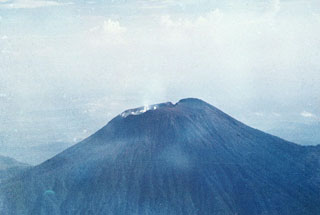Report on Slamet (Indonesia) — 7 August-13 August 2019
Smithsonian Institution / US Geological Survey
Weekly Volcanic Activity Report, 7 August-13 August 2019
Managing Editor: Sally Sennert.
Please cite this report as:
Global Volcanism Program, 2019. Report on Slamet (Indonesia) (Sennert, S, ed.). Weekly Volcanic Activity Report, 7 August-13 August 2019. Smithsonian Institution and US Geological Survey.
Slamet
Indonesia
7.242°S, 109.208°E; summit elev. 3428 m
All times are local (unless otherwise noted)
PVMBG reported that seismicity at Slamet significantly increased beginning in June, with 51,511 signals indicating emissions and 22 tectonic earthquakes recorded through 8 August. White plumes with variable density rose as high as 300 m above the crater rim.Tremor began to be recorded at the end of July with gradually increasing amplitude. In addition, notable inflation was detected at the end of July and long-term temperatures of hot springs showed an upward trend. The Alert Level was raised to 2 (on a scale of 1-4) and the public was warned to stay outside a radius of 2 km.
Geological Summary. Slamet is one of Java's most active volcanoes. It has a cluster of about three dozen cinder cones on its lower SE-NE flanks and a single cinder cone on the W flank. It is composed of two overlapping edifices, an older basaltic-andesite to andesitic volcano on the west and a younger basaltic to basaltic-andesite one on the east. Gunung Malang II cinder cone on the upper E flank on the younger edifice fed a lava flow that extends 6 km E. Four craters occur at the summit of Gunung Slamet, with activity migrating to the SW over time. Eruptions recorded since the 18th century have originated from a 150-m-deep, 450-m-wide, steep-walled crater at the western part of the summit and have consisted of explosive eruptions generally lasting a few days to a few weeks.
Source: Pusat Vulkanologi dan Mitigasi Bencana Geologi (PVMBG, also known as CVGHM)

